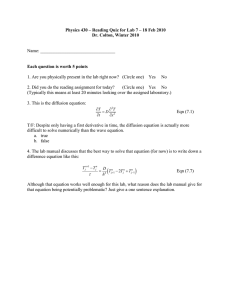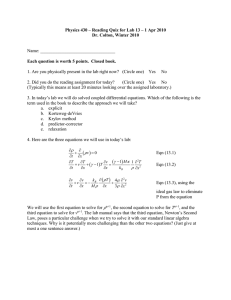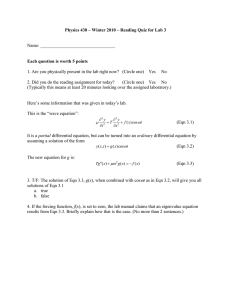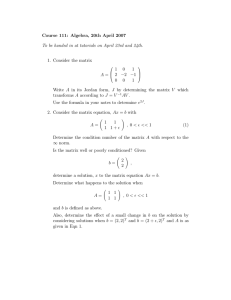The Paradox of Chemical Reaction Networks: Robustness in the face of total uncertainty
advertisement
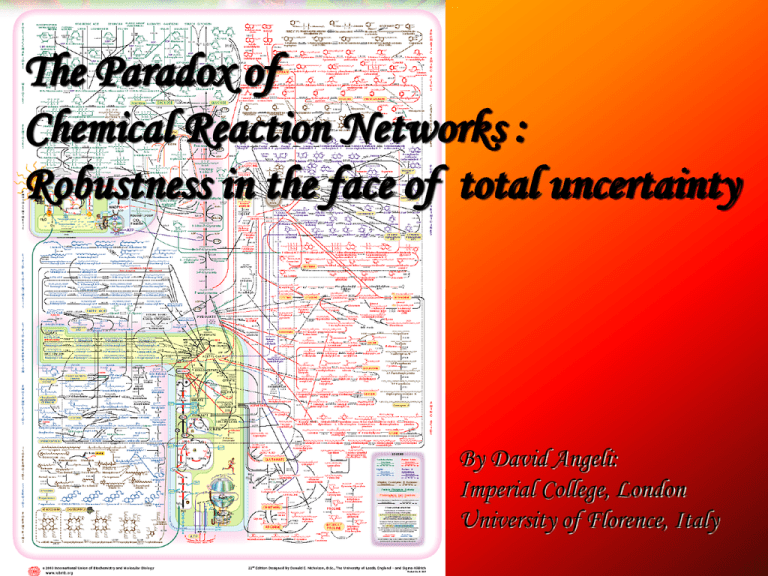
The Paradox of
Chemical Reaction Networks :
Robustness in the face of total uncertainty
By David Angeli:
Imperial College, London
University of Florence, Italy
Definition of CRN
List of Chemical Reactions:
11S1 12 S 2 1n S n 11S1 12 S 2 1n S n
21S1 22 S 2 2 n S n 21S1 22 S 2 2 n S n
r1S1 r 2 S 2 rn S n r1S1 r 2 S 2 rn S n
The Si for i = 1,2,...,n are the chemical species.
The non-negative integers , are the stoichiometry
coefficients.
Example of CRN
E + S0 ES0 E + S1 ES1 E + S2
F + S2 FS2 F + S1 FS1 F + S0
F
FS1
S0
FS2
S1
ES0
S2
ES1
E
Discrete Modeling Framework
Stochastic:
Discrete event systems: PETRI NETS
Reaction rates: mass-action kinetics
F
FS1
S0
FS2
S1
ES0
S2
ES1
E
Problem : Markov Chain with huge number of states
Continuous Modeling Framework
Deterministic:
Continuous concentrations, ODE models
Large molecule numbers: variance is neglegible
Isolated vs. Open systems
• Thermodynamically isolated systems:
Reaction rates derived from a potential.
Every reaction is reversible.
Steady-states are thermodynamic equilibria: detailed balance
Passive circuits analog of CRNs.
Entropy acts as a Lyapunov function.
• Open systems:
Some species are ignored: clamped concentrations.
Partial stoichiometry. Arbitrary kinetic coefficients.
No obvious Lyapunov function.
Possibility of “complex” behaviour.
Relating Dynamics and Topology
• How does structure affect dynamics ?
• How robust is the net to parameter variations ?
• Does the reaction converge or oscillate ?
Qualitative tools: can work regardless of
specific parameters values.
• How to define robustness ?
Consistent qualitative behavior regardless of
Parameters or kinetics.
MAPK random simulation
More random simulations
What is Persistence
• Notion introduced in mathematical ecology:
non extinction of species
• For positive systems
x f (x)
it amounts to:
lim inf xi (t ) 0 i
t
•For systems with bounded solutions equivalently:
( x) R
n
0
Petri Nets Background
F
FS1
S0
FS2
S1
ES0
S2
Bipartite graph:
PLACES (round nodes)
TRANSITIONS (boxes)
ES1
E
P-semiflow: non-negative integer row vector v such that
vS=0
T-semiflow: non-negative integer column vector v with
Sv=0
Support of v: set of places i (transitions) such that v_i>0
Incidence matrix = Stoichiometry matrix = S
Necessary conditions for persistence
•Let r(x) denote the vector of reaction rate
•We assume that for x>>0, r(x)>>0
•Under persistence, the average of r(x(t)) is
strictly positive and belongs to the kernel of S
•Hence, Persistence implies existence of a
T-semiflow whose support coincides with the
set of all transitions.
This kind of net is called: CONSISTENT
Petri Net approach to persistence
SIPHON:
Input transitions
Included in
Output transitions
F
FS1
S0
FS2
S1
ES0
S2
ES1
E
Assume that x(tn) approaches
The boundary. Let S be the set
of i such that xi(tn) 0
Then S is a SIPHON
Structurally non-emptiable siphons
A siphon is structurally non-emptiable if it contains
the support of a positive conservation law
F
FS1
S0
P-semiflows:
E+ES0+ES1
F+FS2+FS1
S0+S1+S2+ES0+ES1+FS2+FS1
FS2
S1
S2
Minimal Siphons:
ES0
ES1
E
{ E, ES0, ES1 }
{ F, FS2, FS1 }
{ S0, S1, S2, ES0, ES1, FS2, FS1 }
All siphons are SNE PERSISTENCE
Network compositions
Full MAPK cascade
22 chemical species
7 minimal siphons
7 P-semiflows
whose supports coincide
with the minimal siphons
Hopf’s bifurcations
• Symbolic linearization:
x f (x)
f
x x
x
• Characteristic polynomial
f
det( sI ) ( s 6 a1s 5 ... a6 ) s 3
x
• Hurwitz determinant Hn-1 = 0 is a necessary
condition for Hopf’s bifurcation (n=6).
Hurwitz determinant
a1
1
H5 0
0
0
a3
a2
a1
1
0
a5
a4
a3
a2
a1
0
a6
a5
a4
a3
0
0
0
a6
a5
• ai are polynomials of degree i in the kinetic parameters
• det(H5) is a polynomial of degree 15 in the kinetic
parameters (12 parameters + 5 concentrations)
• Number of monomials is unknown
• Letting all kinetic constants = 1 except for k1 k3 k5 k7
yields 68.425 monomials all with a + coefficient
Remarks
• This is much stronger than: det(Hn-1) is
positive definite.
• Purely algebraic and graphic criterion for
ruling out Hopf’s bifurcations expected.
• Notion of negative loop in the presence of
conservation laws.
Conclusions
• CRN theory: open problems and challenges
• At the cross-road of many fields:
- dynamical systems
- biochemistry
- graph theory
- linear algebra
HAPPY 60 EDUARDO
